
West Coast - North & La Graciosa
The Island’s North and West coast have some very secluded beaches, caution must be taken as the waters can be dangerous. La Graciosa island has beaches for all tastes.
The commercial and administrative centre of the island, with modern buildings and colourful, shop-lined streets. But the bustle of modern life has not prevented it from conserving the character and style of the colonial fishing village it once was, as may be appreciated when strolling through the towns verdant parks or tree-lined streets of white houses, or when visiting the shoreline of the CHARCO DE SAN GINES, with the fishing boats hauled up onto the beach and the men repairing their nets and tackle. Founded at the beginning of the 15th century, the peaceful fishing village of Arrecife dozed quietly for more than two hundred years until, at the beginning of the 17th century, the devastation of the then capital of the island, San Miguel de Teguise, by invading Berber pirates led the administration to transfer its activities to Arrecife, well protected by its two excellent natural harbours and defences. The castle of San Gabriel which dominates the entire bay from the coast to the islands of EL FRANCES and LOS INGLESES, bears testimony this age of adventure. The castle of SAN GABRIEL was constructed in 1574 by King Felipe II. In 1586 its was razed to the ground by pirates under the orders of the privateer MORATO ARRAEZ. Legend has it that after heroic resistance by the entire town, and following the death of the menfolk, the women opted to put an end to their own lives rather than fall into the hands of the invading pirates. Finally, in 1596, the architect LEONARDO TORRIANI reconstructed the castle, leaving it as it is today and joining it to the city by means of a bridge. This bridge, which still exists, is known as the “Puente de las Bolas” or Bridge of the Balls, because of the spherical stones topping the pillars on which it rests.



SAN MIGUEL DE TEGUISE bears the name of the beautiful daughter of GUARDAFRA, last king of the original inhabitants of the island, the “guanches”, the Princess who married the knight who conquered the island for the crown of Castile, JEAN (MACIOT) de BETHENCOURT. It was through Princess TEGUISE that the agreements and disagreements between her father, the King, and her husband, the conqereror, were channelled, and it was she who finally brought peace and understanding to reign between the two men, and their respective bands. SAN MIGUEL DE TEGUISE, a hamlet turned city, was to become the spiritual and administrative centre of LANZAROTE, and it was from here that the expeditions set forth to conquer the rest of the archipelago. TEGUISE was also a meeting place between CASTILE and AMERICA during the first years of colonization of the new world. Perhaps the word that best defines this ancient capital of Lanzarote is “stately”. The history of the city’s glories and bygone power is written in each and every street, building and monument. Here are austere convents, beautiful churches, the elegant palaces of the nobility that have kept their seal of distinction and continue to inspire respect in spite of the centuries, and spacious houses in stone and brick, with the white walls, large windows and picturesque balconies typical of these the fortunate isles.
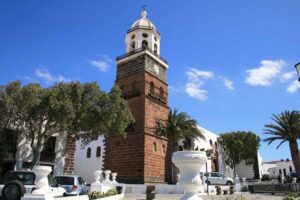

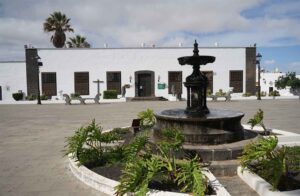
The visitor to TEGUISE would be well advised to climb up to the top of GUANAPAY to visit the crater of this now extinct volcano and the fortress of SANTA BARBARA. constructed in the 15th century, whose keep affords a wonderful view not only of the grey- green countryside of the TEGUISE valley but also of the coast, the sea and the distant dark profile of FUERTEVENTURA and the lesser islands. This fortress was attacked and destroyed several times, and was finally reconstructed and reinforced by the architect TORRJANI in 1586, since when it has remained unchanged. An especially interesting visit in SAN MIGUEL DE TEGUISE is the arts and crafts market, where visitors and the inhabitants of the island alike rummage hrough tiny shops and stalls to discover the most unlikely and fascinating objects produced by the hand of man or by nature. TEGUISE is also the capital of the “timple”, that ancient and most typical of the musical instruments of the CANARY ISLANDS. The secrets of its construction have been passed downfrom one generation to the next, from father to son. The timple, which is native to the area, is a kind of small guitar whose merry sound, reminiscent of Argentina, faithfully reflects the spirit of the people of the islands, at one and the same time reserved and hospitable. These are places privileged by nature where man, mindful of its wonders, has acted with sensitivity and love.
To the north-west of ARRECIFE is the stretch of coast known as COSTA TEGUISE, one of the island’s most important concentrations of tourist installations: 5-star hotels and apartment, bungalow and chalet complexes alongside shops, restaurants, bars, pubs and a wide variety of the highest category sports facilities where the visitor may indulge in whatever individual or group sports he prefers.
This part. of the coast is known as COSTA TEGUISE because a large part of it is located in the area of SAN MIGUEL DE TEGUISE, previously the capital of the island.
COSTA TEGUISE begins a few kilometres from ARRECIFE, and is dotted with coves of golden sand separated by headlands of black lava and with luxurious residential developments surrounded by a sea of green.


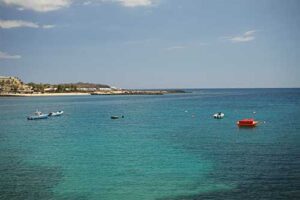
LOS MOLINOS, PLAYA BASTIAN, PUNTA DE TOPE, PLAYA DE LAS CUCHARAS etc…. are some of the most significant spots in this rosary of splendid beaches, bathed by warm crysta waters that boast a particularly rich treasure of marine life, much appreciated by lovers of fishing, and swept by waves and wind they seem to have been created especially for those daring souls whose pleasure is to ride the waters on a board driven by a sail. COSTA TEGUISE has, in fact, become famous throughout the world for the exceptional conditions it offers windsurfers, even the rawest of beginners. The hotels, tourist centres and residential developments are first class, as regards both their quality and comfort and their especially accessible prices. Tourism to the island is continuous from one season to the next, throughout the entire year, even in Winter. Because LANZAROTE’s privileged geographical location gives it a constant warm climate,tourists, especially those who come from tougher climes in search of warmth and smooth beaches accompanied by modern comforts, find on COSTA TEGUISE comfortable lodging, a wide variety of shopping centres, sports and night-life within a frame of incomparable beauty.
To the west of YAIZA lies EL GOLFO, a marvellous natural bay still unaffected by tourism or agriculture. This is a veritable paradise waiting to be discovered by visitors in search of peace, tranquillity and savage beauty in all its untouched splendour. The scenery is just one more of those extraordinary gems that LANZAROTE keeps jealously to itself and then unfolds lilitle by little before the visitor. On the beach there is an emerald green lagoon, separated from the sea by a spit of sand and flanked on the other side by a volcanic cliff, stratified into a hypnotic symphony of colours that contrasts with the deep blue of the sea and the brilliant green of the waters at its foot. EL GOLFO is well worth a visit to enjoy the beauty that nature alone is capable of creating. Very close to EL GOLFO is a small fishing village which is famous throughout the island for its excellent fresh fish and its cuisine. To be found in the lagoon itself are the strange, semi-precious stones known as “olivinas”, with which the local craftsmen make highly original jewellery
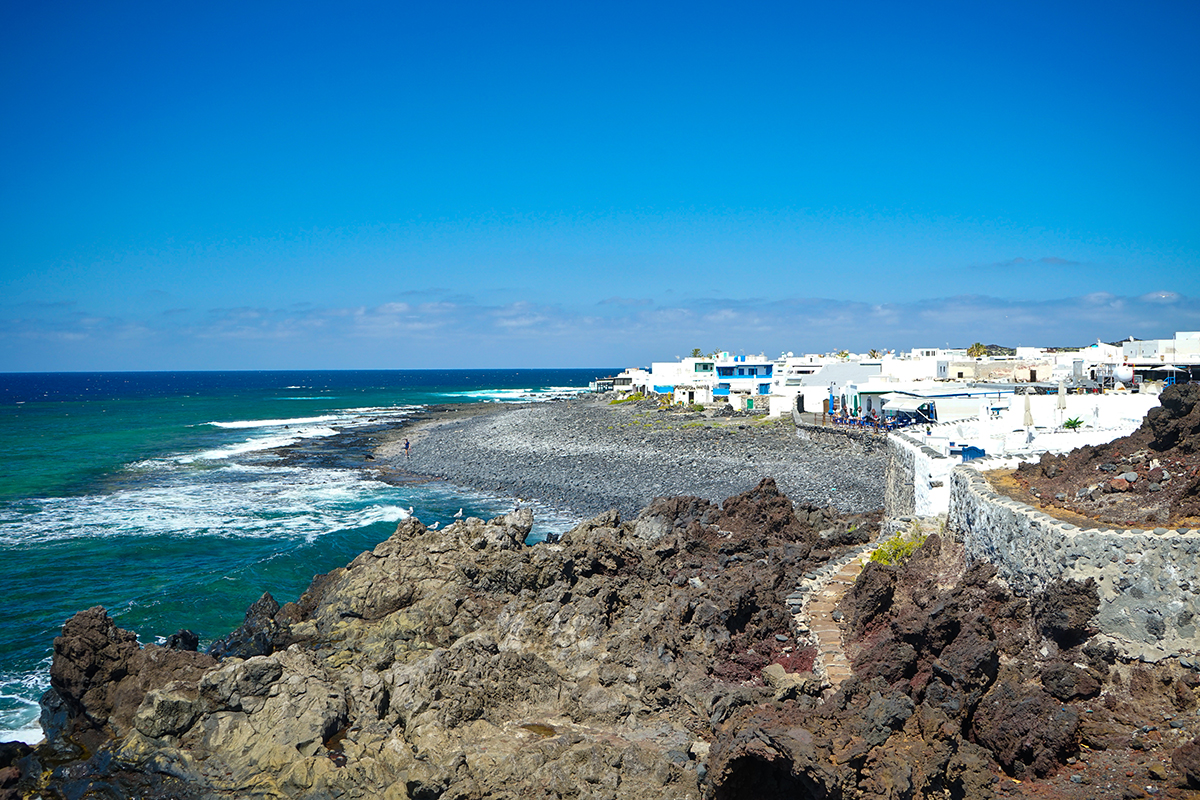
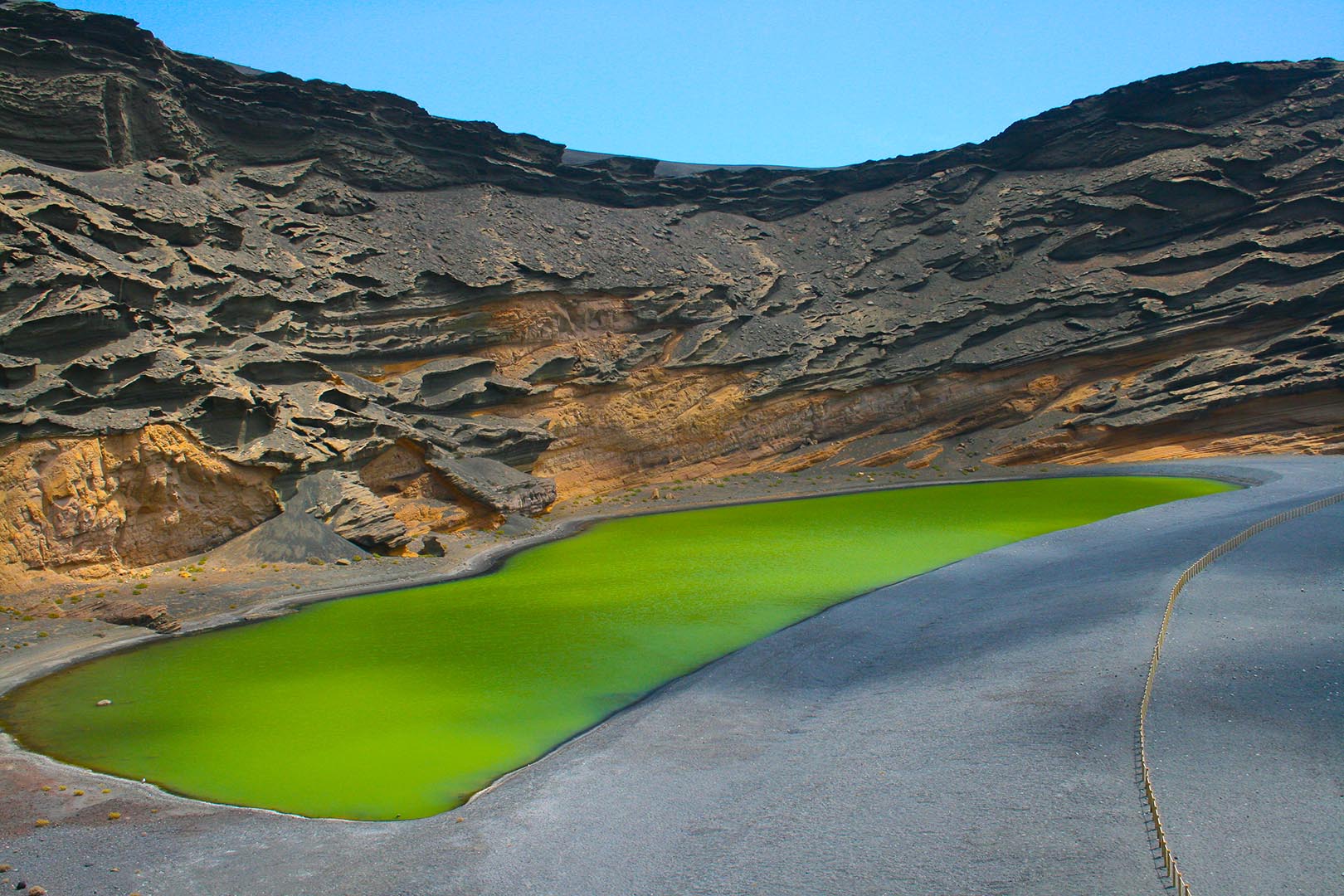
A small fishing port alongside which may be found wide beaches backed by magnificent vertical walls from which to launch out onto the breeze. Vey close to the Mirador del Rio is FAMARA, long famous among gastronomy buffs for the excellent fish to be found in the tranquillity of the old fishing village, and no less famous today among fans of paragliding for the possibilities that its mountains and wide beaches offer for free flight. FAMARA is a small fishing port alongside which are ample beaches that stretch along the foot of the PENAS DEL CHACHE, magnificent vertical walls from which to launch onto the breeze and descend slowly, and without overmuch risk, in a long flight onto the sand.
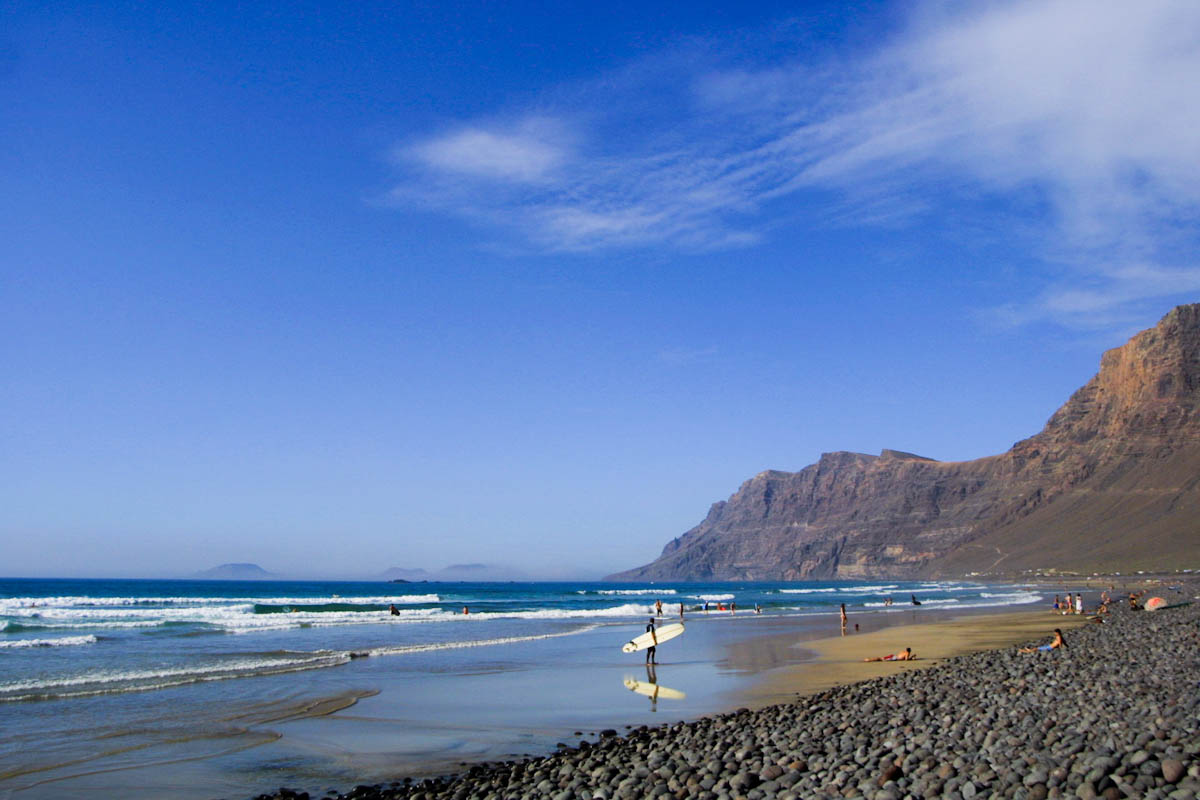
Is colour, shade, purple; the visitor is inevitably surprised on arriving at GUATIZA to find a village like any other but surrounded by a sea of green, a seemingly endless ocean of cactus whose large, oval protuberances blend into weird geometric forms. Surely only some strange caprice of nature could have brought together in one same place such an enormous quantity of plants that elsewhere grow in defiant solitude. But no, this plantation of spines is the work of man, the plants are as well cared for as a field of wheat. The explanation is to be found on drawing near to the plants and observing them in detail, for then one can see that they are covered by myriad tiny insects. These are “cochinillas”, a strange variety of parasite which, when dead, dried and ground, produces an extraordinary natural tint, cochineal, which is used in cosmetics and dyes for its quality and resistance to external agents. This exotic insect, originally from Mexico, arrived on the island in the 17th century and has since become a permanent inhabitant, contributing significantly to the economy of Lanzarote. Another outstanding human work is to be found in GUATIZA, the “jardin de Cactus” or Cactus Garden, created by the great Lanzarote artist CESAR MANRIQUE. Hundreds of different species of cactus rise from the black ash, creating shapes and perspectives that change as the observer moves along the garden’s stone paths, and looming above is the stark whiteness of the windmill of GUATIZA. Like all the works of Manrique, representative for excellence of the soul of Lanzarote, the cactus garden is an ode to life in the midst of apparent bleakness, a symbol of everything that LANZAROTE has always stood for: the work of man transforming the environment and helping life to triumph over the inanimate.


A village in the valley of a thousand palms. A beautiful spot bathed in the colour of the flowers that adorn the balconies and windows of the houses. Haria is a beautiful white village nestling beside the island’s most extensive palm grove. The first thing that catches the visitor’s eye is the profusion of flowers of all colours that adorn the balconies and windows of the houses. Haria does not boast any monuments of particular historical or architectural importance, but what is immediately outstanding is the good taste of the town’s buildings and the way they blend into the landscape. The visitor is recommended to visit the museum of popular sacred art, which abounds in wonderful works springing from the imagination of the people of Lanzarote. Also to be recommended is a short excursion to the MIRADOR DE HARIA, from where the visitor may contemplate the grandiose spectacle of the CORONA volcano – forger of the JAMEOS DEL AGUA and the CUEVA DE LOS VERDES – and the pastoral Landscape of the HARIA valley, with its oases, palms and white houses.

At first glance, LA GERIA might appear to a battle field ripped apart by shellfire, but in fact it is not the result of some crazy war but rather the fruit of the inventiveness and the hard and patient work of the peasant farmers of Lanzarote. LA GERIA is located in an area of volcanic activity, in a landscape of ashes and solidified lava. Over the centuries the area has been razed time and time again by the fury of burning magma, but on each and every occasion its inhabitants have restored its richness and fertility with obstinate tenacity and with the profound knowledge of the soil that man is capable of developing only through love of the land. In each of these crater-like holes, protected by walls of stone against the winds that blow in from the Atlantic, grow vines that yield abundant crops and produce a wine of outstanding quality: Malvasia, a wine that Shakespeare himself praised highly. “El Grifo” is one of the vineyards that specializes in producing and commercializing the wine that is extracted from the Malvasia grape. In spite of there not being rivers or abundant rains, the holes in which these vines grow capture the humidity swept in by the sea breezes thanks to a fine layer of sand and volcanic ash laid by the farmers, a wonderful example of ecological engineering and popular wisdom.


The high quality of its sports facilities has made La Santa a popular training venue among professional sporting personalities. The western coast of the island boasts a particularly beautiful spot that is well worth a visit, LA SANTA. This ancient fishing village now nestles alongside an impressive tourist and sports complex where the visitor may well bump into some of the idols of European sport. CLUB LA SANTA brings together a wonderful natural landscape of limpid lagoons and top quality sports facilities where the visitor’s stay is made pleasant and relaxing by the centre’s well distributed installations, tree-lined avenues, garden and colourful flower beds. CLUB LA SANTA is a favourite venue among professional footballers, basketball players, athletes, etc. from the north of EUROPE for their pre-season or winter training, both for its top quality sports facilities and for its peaceful, relaxing atmosphere and exceptional climate. Facing the development, in the middle of the bay, a small, rounded island emerges from the sea. This is LA ISLETA, an enchanting tropical isle surrounded by an underwater shelf offering excellent fishing, for both anglers and divers. This shelf is relatively shallow and boasts an exceptionally rich marine fauna. Another advantage is that the shelf s absence of currents makes it an ideal place for beginners to dive. LA SANTA is also outstanding for the excellent conditions it offers for windsurfing, due to its quiet waters and steady breeze, and numerous international competitions and tournaments are organized there throughout the year.

Anchored in time, the white town of YAIZA has remained unscathed by the changes imposed by fashion. Although its name is guanche in origin, Yaiza was founded by peasant farmers emigrating from mainland Spain during the early years of colonization of the islands, and this is the way it remains today. Unlike other towns on the island, Yaiza has not been changed by tourism, although it is no less true that it does not possess the monuments or spectacular scenery of other regions. Well worth a visit is the 16th century hermitage of NUESTRA SENORA DE LOS REMEDIOS, reconstructed in the 18th century, whose church houses the image of SAN MARCIAL DEL LIMOGES, patron saint of the island, originally to be found in the cathedral of SAN MARCIAL DEL RUBICON in FEMES
The southern tip of the island is PLAYA BLANCA, one of LANZARQTE’s finest tourist areas. PLAYA BLANCA, originally a small fishing village, has been transformed in recent years by luxurious residential developments and modem hotels, built to take fullest advantage of the area’s benign climate and the quiet transparency of its waters. The cliffs found in other parts of the island give way here to ample beaches of golden sand. PLAYA BLANCA offers the visitor everything necessary for tranquil but fun-packed holidays in a setting of comfort and quality. First class hotels, developments surrounded by splendid gardens, restaurants and bars where all the languages of the world may be heard, sports complexes, all this is an invitation to the visitor to get away from the bustle for a few days and spend his time at sports, or just relaxing. The quiet, limpid waters of Playa Blanca are ideal for exploring in safety the fascinating underwater world, or for indulging in the exciting adventure of skimming across the surface on the wings of the wind. From PLAYA BLANCA it is an easy matter to sail across to the nearby island of FUERTEVENTURA on one of the ferries that make the crossing daily. Near to PLAYA BLANCA, at PUNTA PECHIGUERAS, is the island’s only lighthouse. PAPAGAYO is the name given to a string of golden beaches and sandy coves among the coastal cliffs between “Maya Blanca” and “Punta del Papagayo”. Clear, calm waters and quiet, solitary coves, a world removed from time and without any sense of rush, ideal for fishing, swimming, diving, sunbathing or simply enjoying the pleasure to be derived from doing nothing. On one of these beaches stands the castle of LAS COLORADAS, constructed in the 18th century, which closed the island’s defence system to the south. Destroyed on several occasions and then rebuilt, the castle has recently been restored once more. PAPAGAYO is a world of peace and restfulness, of smooth beaches and quiet waters in which to get away from things and discover the pleasure of contemplation.


ARRECIFE is the administrative and commercial centre of LANZAROTE and SAN MIGUEL DE TEGUISE the island’s historical capital, PUERTO DEL CARMEN is undoubtedly its tourist Mecca. From ARRECIFE southwards are twenty kilometres of low-lying coast with the island’s most beautiful and inviting beaches. PUERTO DEL CARMEN is the most important centre in this area, and offers the visitor comfortable hotels, sports facilities, nightlife and major shopping centres. PUERTO DEL CARMEN is flanked on either side by the beautiful, easily accessed beaches of “Playa Grande” and “Playa Quemada”, with elegant, wooded residential areas that stretch along the sea front. Just to the north of PUERTO DEL CARMEN is LANZAROTE’s only airport, capable of handling both transoceanic flights and the domestic traffic linking the island to the others in the Canary archipelago and to mainland Spain. The airport is modern, comfortable and hospitable, and reflects the style of Lanzarote’s great Cesar Manrique, who participated actively in its and decoration. In spite of the fact that most of the tourists visiting Lanzarote prefer to stay in the area around PUERTO DEL CARMEN, the town’s open spaces and the careful design and distribution of its hotels, residential developments, sports and recreational facilities and shopping areas allow visitors to enjoy their holiday in comfort, without the crowds so typical of many other tourist centres, even of those costing a lot more. The villages of “Los Pocillos” and “Matagorda” have now joined Puerto del Carmen in offering hotel accommodation along this part of the coast. Their beaches join those described above in offering the visitor space to enjoy the wonderful waters of Lanzarote’s Atlantic coast.



The Island’s North and West coast have some very secluded beaches, caution must be taken as the waters can be dangerous. La Graciosa island has beaches for all tastes.
The information contained above is accurate at the time of uploading should ammendments need to take place, then this will be carried out on the next upload.
Photo Gallery: Lanzarote-UK
